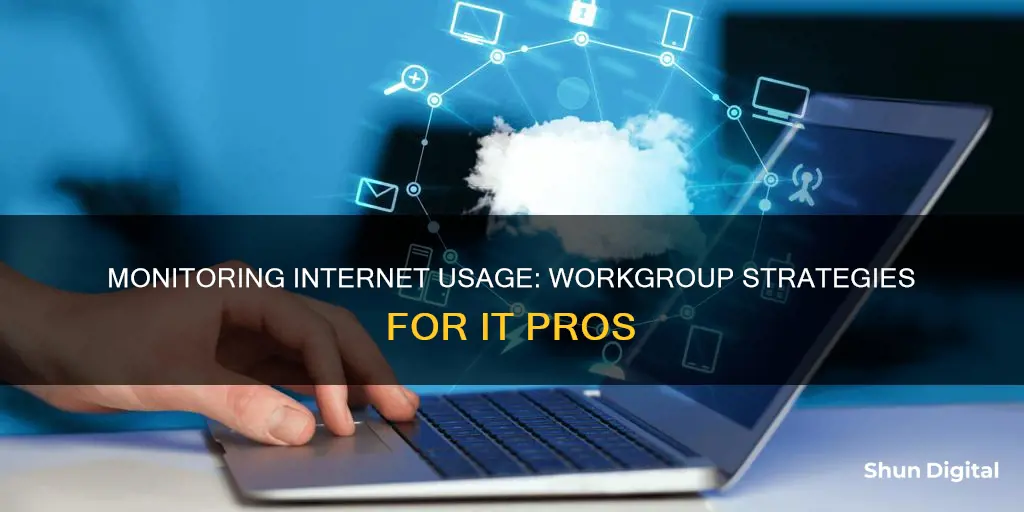
Monitoring internet usage in a workgroup is a complex task that requires a balance between enhancing productivity, maintaining security, and respecting employee privacy. With the rise of remote work and the use of personal devices, employers need to implement ethical and legal monitoring practices to ensure productive and secure internet usage. Unchecked internet access can lead to security threats, reduced employee performance, and compromised company resources. To address these concerns, organizations can utilize employee monitoring software and network monitoring tools to track internet usage patterns, block inappropriate websites, and generate detailed reports on employee activities. However, it is crucial to obtain consent, ensure transparency, and comply with legal regulations to protect employee privacy rights.
| Characteristics | Values |
|---|---|
| Purpose | To improve employee productivity, security, compliance, and cost optimization |
| Tools | Employee monitoring software, network monitoring, firewalls, web filters, network analytics, deep packet inspection |
| Data Collected | Screenshots, websites visited, applications used, keystrokes, network traffic, time spent on websites/applications, productivity scores |
| Benefits | Increased productivity, reduced security risks, policy compliance, optimized internet infrastructure costs, legal liability protection |
| Considerations | Employee privacy, legal and ethical obligations, data security and privacy, balancing productivity and privacy |
What You'll Learn

Monitoring employee productivity
There are several features of employee monitoring software that can help with productivity tracking:
- Automatic time tracking
- User behaviour analytics
- Detailed productivity reports, using productivity metrics and employee time tracking
- Remote desktop control
- Keystroke logging
- App tracking
Some common software for monitoring employee productivity includes:
- BrowseReporter by CurrentWare: This software provides detailed employee productivity reports to help managers understand how employees spend their time at work. It can track the use of apps and websites, and also allows employers to take screenshots of employees' screens.
- Time Doctor: This software has automatic time-tracking features and provides productivity ratings for individual sites.
- Teramind: This software provides advanced business intelligence reports and employee privacy management tools. It also has remote video recording and keystroke logging features.
- Hubstaff: This software has automated timesheets and self-managed productivity tools for individual team members. It also has geofencing features to monitor the time spent by team members at different job sites.
While implementing employee monitoring software, it is important to be transparent about your policies. Being upfront with your employees about the software and how their data is being used can help build trust and avoid feelings of privacy invasion.
Monitoring Android CPU Usage: A Comprehensive Guide
You may want to see also

Protecting company data and systems
- Educate your staff about cybersecurity: Train your employees to recognize security threats and implement security practices. Emphasize that the biggest risk often comes from criminals tricking employees, rather than direct hacking attempts. Teach them the signs of potential attacks and what to do if they suspect something is wrong.
- Set internal controls: Limit employee access to information they need for their specific roles. Log the information each employee accesses and segregate duties to prevent a single employee from having too much responsibility or access.
- Keep software updated: Stay vigilant by regularly updating all software, apps, and operating systems. Vendors release patches and updates to protect against vulnerabilities, so ensure you implement these as soon as they become available.
- Use strong passwords and authentication: Implement strong password policies, including the use of multi-factor authentication, fingerprint or biometric authentication. Avoid common or easily guessable passwords.
- Guard your wireless networks: Create complex passwords for devices connected to your network, such as printers and cameras. Hide your network by disabling SSID broadcasting, and maintain an inventory of permitted devices to automatically bar unauthorized access.
- Encrypt all types of data: Utilize encryption to protect data in transit, in use, and at rest. This will make it indecipherable to hackers in the event of a breach.
- Back up your data regularly: Ensure data is backed up daily to protect against ransomware attacks and ensure business continuity. Consider cloud-based solutions for added security and automatic backups.
- Monitor employee accounts: Regularly analyze employee account logs and behavior to detect unusual login attempts or potential hacker activity.
- Create firm employment agreements: Include clauses in employment contracts that forbid employees from sharing certain types of information. This helps reduce the transmission of sensitive data through potentially vulnerable channels.
- Plan your response to data breaches: Have a comprehensive response plan in place to address security incidents. This should include immediate actions, such as disconnecting compromised computers, as well as notifying relevant parties and conducting investigations.
- Stay up to date with cybersecurity measures: Invest in cybersecurity programs and tools to protect your network and devices. Stay informed about new threats and updates, and conduct regular cybersecurity audits to identify and address vulnerabilities.
- Secure physical documents: Store physical documents containing sensitive information in locked cabinets or rooms, and dispose of them properly by shredding or burning.
- Maintain a device inventory: Only allow authorized devices to access your network and data. This helps prevent unauthorized access and reduces the risk of lost or stolen devices containing sensitive information.
- Minimize data collection: Collect and retain only the information necessary for your business operations. This reduces the amount of data that could potentially be compromised in a breach.
Monitoring Bandwidth Usage: A Guide for Cisco Routers
You may want to see also

Ensuring legal compliance
Monitoring employee internet usage can help organisations enhance productivity, improve security, and enforce compliance with company policies. However, it is essential to ensure that monitoring practices comply with legal requirements to avoid liabilities and penalties. Here are some guidelines for ensuring legal compliance when monitoring internet usage in a workgroup:
- Privacy Laws: Organisations must comply with privacy laws such as the General Data Protection Regulation (GDPR) in the European Union or state-specific privacy laws in certain states in the United States. These laws dictate how employee data can be collected, stored, and used. Organisations should implement policies that address employee privacy rights and obtain consent from employees for monitoring practices.
- Transparency: Employers should be transparent about their monitoring practices. Inform employees about the monitoring of internet usage, email communications, and other online activities. Create a monitoring policy that outlines the company's practices and obtain employee signatures, granting permission for monitoring. Transparency helps maintain trust and avoid ethical issues.
- Proportionality: Monitoring practices should be proportional to the organisation's needs. Only collect and process data that is necessary for achieving specific purposes, such as improving productivity or security. Avoid excessive monitoring that may invade employees' privacy.
- Data Security: Ensure that any data collected through monitoring is securely stored and protected. Implement appropriate technical and organisational measures to safeguard employee data from unauthorised access, misuse, or disclosure. This includes using secure networks, encryption, and access controls.
- Purpose Limitation: Use the collected data only for the purposes specified in the monitoring policy. Do not use employee data for unrelated purposes without obtaining additional consent. For example, if monitoring is implemented for security purposes, do not use the collected data for performance evaluation without informing employees beforehand.
- Employee Rights: Inform employees about their rights regarding the monitoring of their internet usage. This includes the right to access their own data, request corrections, and withdraw consent for processing, subject to applicable laws and organisational policies. Provide employees with clear procedures for exercising these rights.
- International Considerations: For multinational organisations, be mindful of the varying legal requirements across different countries. Many countries outside the United States have strict regulations regarding employee monitoring, including prohibitions on disclosing information about employees' internet usage and email communications. Ensure compliance with the laws of each jurisdiction in which the organisation operates.
- Regular Reviews: Conduct regular audits of monitoring policies and practices to ensure ongoing compliance with legal requirements. Stay updated with changes in legislation and adapt policies accordingly. Regular reviews also help identify and address any technical or procedural shortcomings in the monitoring process.
By following these guidelines, organisations can ensure that their monitoring practices are legally compliant and respect the privacy rights of their employees. It is important to strike a balance between achieving organisational goals and protecting employee privacy.
Fortnite Usage: Monitoring Your Child's Gameplay
You may want to see also

Preserving employee privacy
Monitoring employee internet usage is a complex issue that requires a careful balance between preserving employee privacy and maintaining a secure, productive work environment. Here are some strategies to preserve employee privacy while monitoring internet usage in a workgroup:
Clear Policies and Transparent Communication
Establishing transparent guidelines and open communication is crucial. Companies should clearly communicate what information is being monitored and why. Employees must understand the reasons behind monitoring and how it contributes to overall security without focusing excessively on their privacy. It is essential to establish that monitoring is not about invading their personal space but about maintaining a well-functioning workplace.
Limited Monitoring Scope
To preserve privacy, focus monitoring efforts only on work-related activities. Avoid monitoring personal emails or websites to maintain a balance between keeping work secure and respecting personal space. Employers can also inform employees that monitoring is limited to company-owned devices during working hours, providing clear boundaries.
Employee Consent and Involvement
Involving employees in the process of creating monitoring policies can foster trust and help them understand the importance of a secure work environment. Seeking their input shows that their privacy is valued, and their consent should be obtained where legally required.
Anonymized Data Collection
Collecting and analyzing data without attributing it directly to individuals helps protect employee privacy. By analyzing trends without pinpointing specific employees, companies can respect privacy while identifying broader security issues.
Use of Third-Party Software
Employing robust third-party monitoring tools that are specifically designed for employee internet usage monitoring can help strike a balance between security and privacy. These tools can track internet activity, detect risky behavior, and generate reports without interfering with personal privacy.
Legal Compliance
Adhering to local laws and regulations regarding employee monitoring is crucial. Some regions, such as Connecticut, California, Louisiana, South Carolina, and New York in the USA, have specific rules about employee monitoring and privacy protection. Understanding and following these laws is essential to maintain a legally compliant and ethical monitoring system.
Data Security and Privacy
Organizations must implement stringent measures to secure monitored data. This includes encrypting stored data, using secure connections, and restricting access with multi-factor authentication. Additionally, data retention policies should be in place to delete logs after a defined period, reducing the risk of a data breach.
In summary, preserving employee privacy while monitoring internet usage in a workgroup requires a thoughtful approach that balances security and privacy concerns. By implementing clear policies, limiting monitoring scope, obtaining consent, anonymizing data, using appropriate tools, complying with legal requirements, and safeguarding data, companies can maintain a productive and secure work environment while respecting employee privacy.
Monitoring Bandwidth Usage: Wireshark's Essential Guide
You may want to see also

Reducing security risks
Monitoring employee internet usage is an important way to reduce security risks, but it must be done ethically and with transparency. Here are some ways to reduce security risks while respecting employee privacy:
- Set Clear Expectations and Policies: Establish comprehensive internet use policies that address business needs, legal requirements, and ethical concerns. Be transparent about what data will be collected, who can access it, and how it will be used. Obtain employee consent and make sure they understand the monitoring practices.
- Use Appropriate Software and Technology: Implement specialized employee monitoring software (EMS) to track internet usage patterns, record screens, log websites visited, monitor applications, and log keystrokes. Use network-level monitoring tools such as firewalls, web filters, network analytics, and deep packet inspection to control and analyze internet traffic.
- Secure and Protect Data: Ensure that collected data is anonymized, associated, and securely stored with strict access controls and encryption. Only authorized managers should be able to access the data, and multi-factor authentication should be required. Implement data retention policies to reduce the risk of data breaches.
- Provide Training and Feedback: Use the collected data to provide constructive feedback to employees rather than punitive action. Offer cybersecurity awareness training and guidance on acceptable vs. prohibited internet use. Counsel employees who violate policies, and reserve discipline for egregious or repeated cases.
- Balance Monitoring with Privacy: Limit monitoring to required devices, times, and activities. Only track company-owned devices during working hours, and disable monitoring outside of work hours. Respect employee privacy by seeking their input when creating policies and addressing their concerns.
- Remote Worker Considerations: For remote workers, install monitoring software on company-issued devices to maintain visibility. Use VPNs to route internet traffic back to the corporate network for better monitoring. If legally permissible, obtain consent to install monitoring agents on personal devices used for work, but respect employees' privacy and limit monitoring to work-related activities and times.
- Selective Monitoring: Be selective about the data you track and how you use it. Focus on enhancing productivity and security rather than policing employees. Use the data to trigger supportive actions, such as training, rather than punitive steps.
Monitoring Power Usage: A Comprehensive Guide to Energy Efficiency
You may want to see also
Frequently asked questions
Monitoring internet usage in the workplace can eliminate distractions, reinforce security policies, and ensure that company resources are being used appropriately. It can also help to create an audit trail that can be used as evidence in case of security violations and potential litigation.
There are several tools available for monitoring internet usage, including Hubstaff, BrowseReporter, WorkTime, and DataSecurity Plus. These tools can help track websites visited, monitor applications, and provide insights into employee productivity.
Monitoring internet usage without consent or transparency can be problematic. It is important to set clear expectations and policies, communicate transparently, and respect employee privacy as much as possible. Organizations should also adhere to relevant laws and regulations regarding employee monitoring, which can vary by region.







